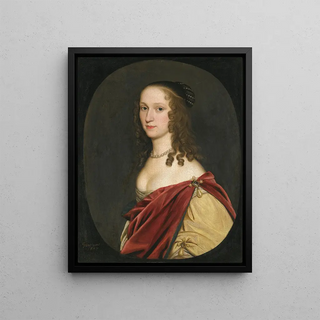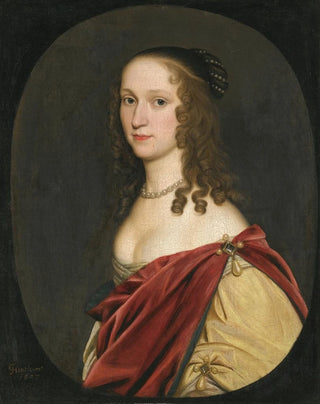Art print | Portrait of a lady - Gerard van Honthorst


View from behind

Frame (optional)
Portrait of a Lady - Gerard van Honthorst – Captivating Introduction
The "Portrait of a Lady" by Gerard van Honthorst is a work that transcends time and invites the viewer to delve into the intimacy of a frozen moment. Created in the 17th century, this painting embodies the very essence of the classical portrait, where the personality of the subject blends with the technical virtuosity of the artist. The soft light enveloping the lady's face creates an atmosphere that is both mysterious and warm, evoking a sense of curiosity and admiration. This artwork, through its elegance and depth, is a true testament to the art of portraiture of its era—a window into the history and customs of a bygone time.
Style and uniqueness of the work
Honthorst's style, influenced by chiaroscuro, is evident here in the subtle use of shadows and lights. The way the light caresses the lady's face, highlighting her delicate features, demonstrates impressive technical mastery. Every detail, from the fabric of her dress to the reflections in her eyes, is rendered with precision that captures the very essence of her being. The composition is carefully thought out, placing the lady at the center of attention while revealing a discreet background that enhances her presence. This approach gives the artwork an almost lifelike dimension, where one might expect the lady to speak at any moment. The color palette chosen by Honthorst, blending warm tones with darker shades, intensifies the emotion conveyed by this representation, making the portrait both accessible and mysterious.
The artist and his influence
Gerard van Honthorst, an emblematic figure of the Dutch school, established himself during his career as a master of portraiture. Raised in the flourishing artistic context of the Baroque period, he was influenced by artists such as Caravaggio, whose dramatic use of light left a mark on his style. Honthorst developed a personal approach, incorporating elements of everyday life into his works, making his portraits not only faithful representations but also visual stories. His influence endures through

Matte finish

View from behind

Frame (optional)
Portrait of a Lady - Gerard van Honthorst – Captivating Introduction
The "Portrait of a Lady" by Gerard van Honthorst is a work that transcends time and invites the viewer to delve into the intimacy of a frozen moment. Created in the 17th century, this painting embodies the very essence of the classical portrait, where the personality of the subject blends with the technical virtuosity of the artist. The soft light enveloping the lady's face creates an atmosphere that is both mysterious and warm, evoking a sense of curiosity and admiration. This artwork, through its elegance and depth, is a true testament to the art of portraiture of its era—a window into the history and customs of a bygone time.
Style and uniqueness of the work
Honthorst's style, influenced by chiaroscuro, is evident here in the subtle use of shadows and lights. The way the light caresses the lady's face, highlighting her delicate features, demonstrates impressive technical mastery. Every detail, from the fabric of her dress to the reflections in her eyes, is rendered with precision that captures the very essence of her being. The composition is carefully thought out, placing the lady at the center of attention while revealing a discreet background that enhances her presence. This approach gives the artwork an almost lifelike dimension, where one might expect the lady to speak at any moment. The color palette chosen by Honthorst, blending warm tones with darker shades, intensifies the emotion conveyed by this representation, making the portrait both accessible and mysterious.
The artist and his influence
Gerard van Honthorst, an emblematic figure of the Dutch school, established himself during his career as a master of portraiture. Raised in the flourishing artistic context of the Baroque period, he was influenced by artists such as Caravaggio, whose dramatic use of light left a mark on his style. Honthorst developed a personal approach, incorporating elements of everyday life into his works, making his portraits not only faithful representations but also visual stories. His influence endures through






